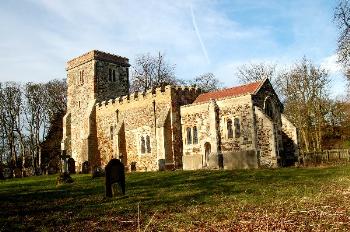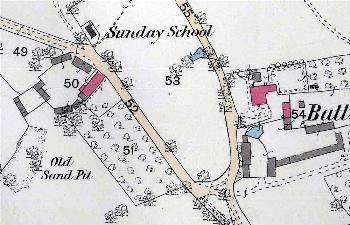Early Education in Battlesden

Battlesden church from the south-east January 2007
As may be expected from a place so small there are not very many records referring to education in Battlesden.
Volume 81 published by Bedfordshire Historical Records Society (2002) is a series of episcopal visitations edited by former County Archivist Patricia Bell. At each visitation a list of questions was sent out in advance, one of which enquired about the provision of schools in each parish. The various replies were as follows:
- 1706: "There is no Lecture, Schole, Almeshouse, or Hospital in this parish";
- 1709: No public or Charity Schole, but a Woman teaches 13 children, being all that are in the parish, encouraged by Mr.Bathurst";
- 1717: "No Publick or Charity School";
- 1720: "No Charity School"
In 1818 a Select Committee was established to enquire into educational provision for the poor. This was no doubt prompted, in part, by the recent foundation of two societies promoting education and specifically the building of schools. The Society for Promoting the Lancasterian System for the Education of the Poor was established in 1808 promoting schools run along the lines pioneered by Joseph Lancaster, who had himself copied those of Dr.Andrew Bell, in which older children taught their younger fellows. The Society was renamed the British and Foreign School Society in 1814,. It was supported by a number of prominent nonconformists, Lancaster himself was a Quaker, and sought to teach a non-sectarian curriculum. In answer to this perceived nonconformist takeover of local education the National Society was formed in 1811 to encourage the teaching of poor children along Anglican lines, including the catechism. The Select Committee sent a questionnaire to all parishes in the country asking for: particulars relating to endowments for the education of children; other educational institutions; observations of parish needs etc. The return for Battlesden noted a Sunday School existed supported by the rector who was of the opinion that "the poorer classes employed in lace-making…would not avail themselves of weekly schools".
In those days a Sunday School was just that, a school which met on a Sunday, usually in the church or nonconformist chapel or other similar building, teaching more than the religious topics with which they are associated today.

1882 map showing Sunday School
In the country generally the number of schools built continued to grow over the next fifteen years so that by 1833 the government agreed to supplement the work of the two societies, and local benefactors, by making £20,000 per annum available in grants to help build schools. It also prompted another questionnaire to be sent to each parish in England asking for details of local educational provision. The questionnaire for Battlesden recorded a Sunday School of 15 children supported by a £2 per annum donation from a clergyman; a few children also attended school "in an adjacent parish" [probably Potsgrove].
The next national enquiry was in 1846/7 when the Church of England made an enquiry as to all its church schools. This was against the background of a new Whig government which championed secular education and the increasing importance of nonconformists, particularly Wesleyan Methodist, and Roman Catholics in providing schools. Battlesden reported a Sunday School for the united parish of Battlesden with Potsgrove of 15 children of each sex, which was supported by the Rector.